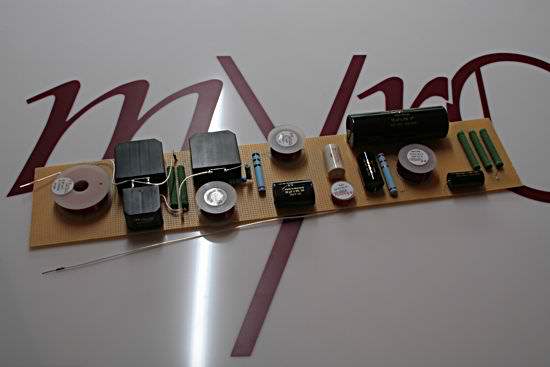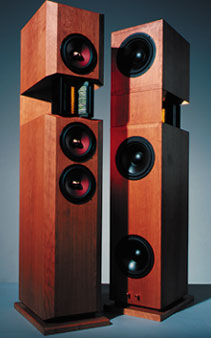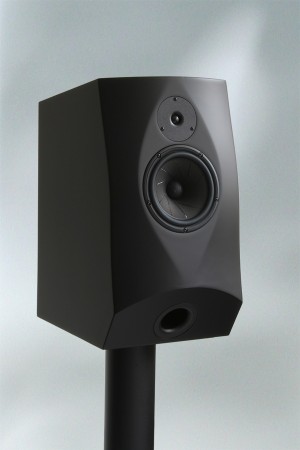Why do you need filters?
Loudspeaker drivers are not perfect. That's why filters have to be placed in front of each driver to correct unwanted behaviour and to optimise the interaction with the other drivers of the loudspeaker. Filters should only be used to correct non-linearities that do not occur only at certain angles. There are many resonances that (e.g. on axis) lead to extreme overshoots, but form a dip under angles (e.g. 30 degrees) because the partial oscillations cancel each other out under this angle. Especially with drivers that are open in their upper frequency range, i.e. full range drivers, these problems show up mercilessly. (And they are not even covered by the sound component of a tweeter).
The best crossovers primarily eliminate detail-eating, distortion-producing impurities and protect drivers from operating conditions that lead to high distortion. There are several established ways of doing this.
The first fraction of developers swears by limiting the transmission range as steeply as possible to the middle, optimally usable transmission range of the drivers.
The disadvantage: heavily distorted transients without the original temporal references. Steep filters are a prime example for energy destruction or transformation, for subtractions (especially in the transient!). Acoustic subtractions are not a loss per se. They can also be used as a welcome tool for correcting erroneous transmission behavior. That is the intelligent way to deal with it. But this also has to be thought of "dynamically".
The second fraction of developers swears by flat filters (6 dB / octave), because analog theoretically only with them time-correct loudspeakers can be built.
The disadvantage: The drivers are operated in limit ranges and distort due to their non-linearities.
The third fraction of developers uses medium steep slopes (12 - 18 dB / octave) in the sense of a compromise. Such tunings are the most commonly encountered. They are reasonably resilient, little complex, comparatively cheap considering the overall effort in development and in the implementation within the production.
The disadvantage: The transient response is also distorted here and the chassis are operated at least proportionally in the non-linear range.
|

Crossover of the Myro Whisky
|
The drivers normally take leave just above and below the crossover frequency at 18 dB/octave or 12 dB/oct through the chassis response plus, for example, 1st order filter (6 dB/oct). These steep slopes are a big problem with analog loudspeakers because of the strong phase rotation with respect to the goal of in-phase, synchronous transient response - the formation of the original sound form. Interference problems occur primarily due to non-symmetrical chassis arrangements, chassis distances that are too large in relation to the jointly radiated frequency, and the aforementioned phase rotations. Wide overlapping ranges with linear flanks and minimal phase rotations, on the other hand, are relatively unproblematic, as long as the symmetrical arrangement and sufficiently small distances are maintained. The summation then works so well that clean signal shapes result in the sum. If one finds the right mixture with regard to the mentioned factors, then a good crossover behaviour for the perception of the listener in the listening range is attainable, and this without having to renounce the correct conversion of the sound signals.
|
Measurement proof:
Use an oscilloscope and measure a chassis with a sine burst, better yet with a sine period or a sine half wave. The measurement with sine oscillations (sine periods) excites the loudspeaker from the rest position in an unambiguous way, equivalent to the natural sound events. When switching different filters in front, one sees the change of the temporal expansion of the first half-wave and the amplitude changes corresponding to the filter slope, while the temporal origin remains the same.
|
Extreme slopes have their problems when coupling different specialized chassis. There is an abrupt transition from the radiation behaviour of one (e.g. bass-midrange driver) to the other (e.g. tweeter dome). This also results in significant drops in the polar diagram (frequency response). Only a diffusor for the bass-midrange driver or a bundling sound guide for the tweeter can help against this, whereby an imbalance between the fundamental range and the mid-high range also arises. In the initial digital euphoria, super-steep filters were applied, which were withdrawn again for this and other reasons.
With a vertical chassis arrangement, another aspect arises for the vertical dispersion characteristics. If we look at the sound reproduction of transients, steep-edged transitions with non-symmetrical chassis arrangements are usually inferior even to symmetrical arrangements with flatter transitions. Each application requires a dispersion pattern that is tailored to the specific installation conditions. Digitally, and thus with steep filters, much can be corrected. But does the correction correspond to the nature of the error and can it also be correct outside a specific reference point?
|
Example 1:
In the direction of a certain reference point the transmission behaviour is measured and corrected. At this reference point the running times of the chassis are in a certain relation, this is corrected at this location. If we change the reference point, completely different delay relations will result and the correction made cannot possibly be correct there as well.
Thus, the waveforms there, the sound will be distorted.
|
Example 2:
Loudspeaker chassis have various resonance phenomena and thus a quite certain sound character. The membrane resonances, for example, are not the same under all radiation angles, or have any effect at all. If one corrects the membrane resonances under a certain radiation angle, i.e. in relation to a certain reference point, then this correction turns into the opposite under other angles.
|
|
Example 3:
When the drivers are steeply separated, the sound character created by the specific resonances and non-linearities of the drivers changes from one octave to another. A Steinway then sounds as if it were a Steinway in the bass, a Bösendorfer or similar in the mids, and a Kawai grand or similar in the upper octaves.
|
Example 4:
If the directional characteristics do not match exactly when there is a steep separation, the result is a steep dip in omnidirectional response.
|

ESS AMT 1 Tower
|
The analog allpass
Allpasses provide phase shifts without changing the amplitude. That's why it seems reasonable to assume that the acoustic centers of the drivers, wired with allpasses, could be corrected electrically instead of bringing them into alignment by mechanical offset. But this is not so. An allpass can't delay the entire transmission bandwidth of a driver for a constant amount of time. An allpass shifts energy as a function of frequency. It exhibits a frequency-dependent group delay, which can be used to delay the signal in a frequency-dependent manner. Since this frequency dependence exists, one is confronted with these consequences in practice at the real loudspeaker. One must inevitably deal with the frequency-dependent mode of action.
Analog filters do not shift the time origin of signals. Therefore, in the transient, no chassis rushes ahead or behind in this respect; the beginning of the transient remains unaffected. There is no analog filter that can shift the starting point of a chassis on the time plane, because the time-shifting effect of analog filters only starts in the sequence. Filter circuits exert their time-shifting, energy-delaying effect on signal conversion only from the starting point of the signal. This is amplified by the similar inherent behaviour of the loudspeaker chassis. The only reason for an advance or retardation in the transient response is to be found in different long distances from the sound origin to the listener / microphone. Group delay evaluations, which give impressions deviating from this, show us the problems of the metrological models. The invariability of the starting points can be easily reproduced with oscilloscope measurements during transient response.
Sometimes a trick is used: The starting edge of the woofer is extremely tilted, the fast part is filtered away so extremely that one could have the impression that there is a time shift of the starting point. But the time origin is not really delayed. A delay line would theoretically be able to do this, but this is forbidden for sonic reasons.
Digital technology offers extended possibilities here. In digital crossovers, values can be temporarily stored and read out again after a defined time. This is the digital counterpart to the analogue delay line without its side effects. By using digital crossovers, the cabinet design can actually be simplified.
|
Would active speakers be better?
Loudspeaker drivers have series scattering - and that very clearly, unfortunately also with the renowned manufacturers. A very good signal response can only be achieved if (despite the selection of drivers) each speaker is tuned individually. It is not uncommon to have to change the circuit layout. With passive loudspeakers this can be done without any problems. With active loudspeakers, however, where corresponding EU directives (EMC) apply, with tests and declarations of conformity, the manufacturing costs and the effort would explode because of the bureaucratic effort. Such a meticulous work, as Myro does, is easier to do passively. And doing it that way, in all experience, determines much more the sonic result. Properly tuned passive filters, taking into account the driver behaviour over time, result in a total load on the amplifier that can be more benign in terms of impedance and electrical phase (over time) than a single driver at the amplifier output. If you operate with so-called zero-ohm coils in the bass, you also hardly lose any damping. Some badly fitted or oxidised connectors or a bad solder joint have a higher internal resistance. You can also put the power amp directly to the speakers, so there are no long cable runs.
(Copper foil zero ohm coil + power amplifier directly at the speaker = super damping).
Furthermore, the quality of the bass driver and its mounting situation is just as crucial. The generously dimensioned electrical / thermal load capacity of the crossover components also dispels any worries here.
The argument of the power amp quality should also be considered. One should reluctantly refrain from using, for example, the Myro Whisky or the Myro Ocean on a very good amplifier like the Audionet Max. But with the given amplifiers in an active speaker you are fixed and limited. Nobody builds power amplifiers of such a calibre into a three-way active speaker. That would drive the base price offside. The big difference is not in the concept - active / passive / analogue / digital - but in the accuracy of the conversion.
Errors in this process lead to much greater sound distortion than the fundamental differences between the concepts mentioned.
Can digital filters do everything better?
Digital filters can solve some problems, but they are not superior to analog filters in all respects. For example, they can be used to correct the acoustic centers of the drivers without the need for a slanted baffle. Also, steep-edged filters can be generated without strong phase rotations. This facilitates the selection of suitable drivers.
The slope of a filter to be used is also subject to different optimization criteria for digital filters. A very steep filter, for example, is better at blocking out frequency ranges that a driver cannot reproduce well (increased distortion, breaking diaphragm). However, steep filters inevitably have a longer ringing because of the sharpness of the kink. Now, not only one driver is playing, but at least two drivers are playing together at a crossover, and in doing so they oscillate against each other in the temporal transient range of the filters, thereby creating a (necessary) mutual cancellation. But it is easy to imagine that with the added intrinsic behaviour of the drivers the cancellation is not perfect. And the longer the ringing takes place, the greater the likelihood that it won't be a perfect match. Already you can hear the difference compared to a flat filter.
Also for the tuning of a digital filter, e.g. an FIR filter, it is equally necessary to define a location to which all measures refer: a defined distance, a defined angle. If we now linearize the sound response of a loudspeaker at this location, this construct collapses, for example at a vertical angle, if the drivers are arranged vertically. And this is exactly the case with steep-sided filters. Interference occurs not only in the superposition of transient tones, but also in impulses and transients of all kinds. Under a vertical angle with a vertical chassis arrangement, the sound travel times of the different chassis to the detection point are unequal. Thus the reproduction of an impulse / transient is no longer possible. The electroacoustic transducer converts incorrectly!
What FIR filters also cannot change are the partial oscillations of a membrane and the - especially with full range drivers - often very uneven dispersion behaviour.
|

MW Profidelity
|
<zurück: Myroklopädie>
<zurück: Myro>


